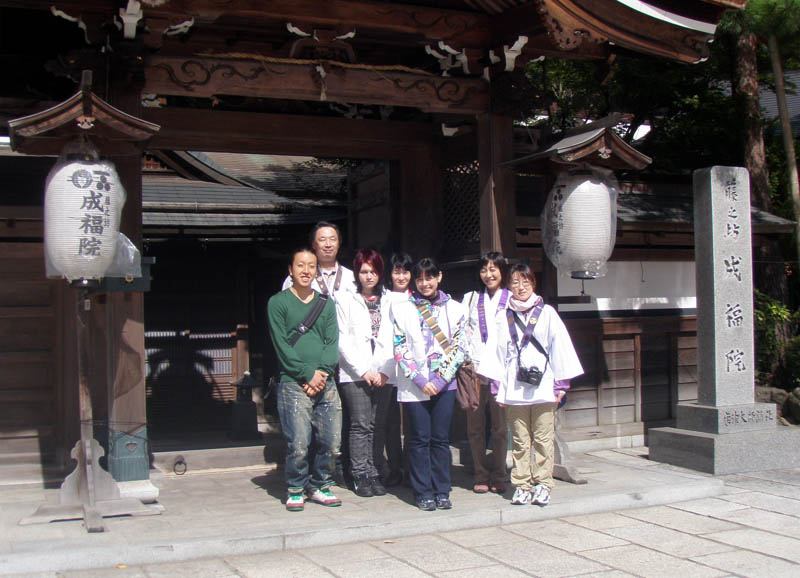
Kôyasan is a name of a mountain and, at the same time, a name of a temple. On the top of the mountain there is a big temple named Kongô-bu-ji, ‘Diamond Peak Temple’. Kûkai, or often called Kôbô-daishi, founded the temple in 819, C.E. He went to China to learn Buddhism, and introduced Vajra-yâna, or Tantric Buddhism, which was a new way of thought at that time. After coming back, he worked energetically to propagate what he had learned. All the Buddhists were deeply influenced by him, and Vajra-yâna became a standard of Japanese Buddhism until Kamakura era, when some masters, for example, Hônen, Dôgen, or Nichiren, advocated new trends of Buddhism that was assimilated to the Japanese way of thinking. Still, Kôyasan remained as a center of Buddhism, and, even today, it is regarded as one of the most sacred places in Japan.
From Ôsaka to Kôyasan it takes one and half hours by train. Seven pilgrims, including Jolanta and Nara, wearing white coats with the name of Kôbô-daishi on the back, arrived at the mountain in the late morning. First we visited Kongô-bu-ji, which was famous for its gorgeous architecture and beautiful gardens. We see many pictures on sliding paper doors. We see gardens with white sand and black stones. We see gorgeous living rooms and a big kitchen. Everything was amazing. Next we went Oku-no-in, ‘inner temple’, where Kôbô-daishi was worshipped. There are many tombs on the both side of the way. Some of them are very old, built in Kamakura era or Muromachi era, and many of them are of Edo era. Mysterious atmosphere was drifting among big trees. At Oku-no-in, we chanted Buddhist sutras. It was indeed a deep spiritual moment.

We stayed at a shukubo, ‘pilgrim’s lodging’. Dinner there was vegetarian, but so splendid. This was the first 100% Japanese dishes for Jolanta and Nara. They seemed to like them. Next morning, from six o’clock, there was a morning ceremony. Three monks prayed and chanted ancient holy songs. Beautiful dawn was coming while we were drunk with silence.
After taking breakfast, we went down the mountain a little bit, and returned through Chô-ishi-michi, ‘mile stone road’. There are big stone posts every 100 meters. The first post is by Jison-in temple in the foot of the mountain. From there to Dai-mon, ‘Great Gate’, of Kongô-bu-ji, there are 180 posts. On each post the number is carved in descending order from 180 to 1. We walked from the 39th post to the 7th. It is very encouraging that the number is decreasing.
This may be a very strange way to welcome foreign friends. Nowadays, only a few Japanese wear white coats to visit Kôyasan, and fewer walk along Chô-ishi-michi. I, however, wanted Jolanta and Nara to experience ‘deep’ Japan. Even sightseeing bus tourists can experience superficial things like gorgeous pictures of Kongô-bu-ji, but only a chosen few can walk in the beautiful forest of Chô-ishi-michi. Actually, this is one of the most blessed spaces in Japan.
At Dai-mon we took the last souvenir picture and returned back to Osaka with profound satisfaction.

